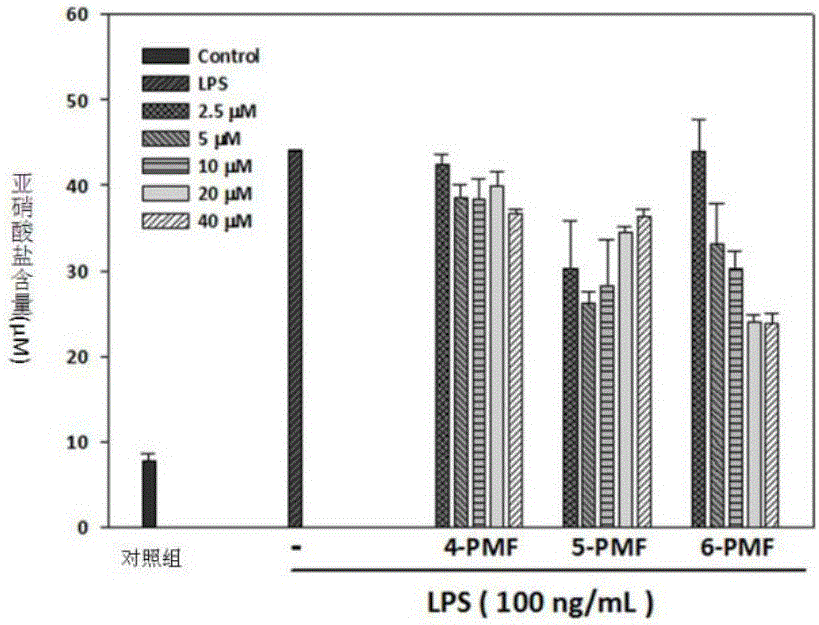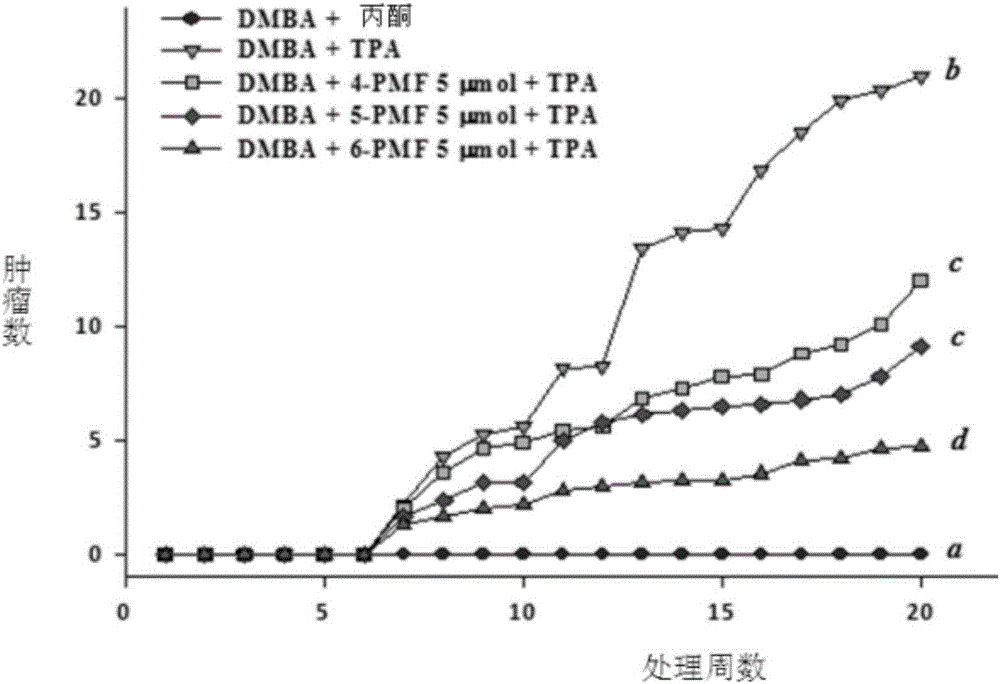Application of polymethoxyflavonoids on medicine prepared for treating skin papillomatosis
The technology of polymethoxyflavones and tetramethoxyflavonoids is applied in the application field of polymethoxyflavonoids in the preparation of medicines for treating skin papilloma, and the effects of wide sources and remarkable therapeutic effects are achieved.
- Summary
- Abstract
- Description
- Claims
- Application Information
AI Technical Summary
Problems solved by technology
Method used
Image
Examples
Embodiment 1
[0026] Example 1 Effect of polymethoxylated flavones on the nitrite content of mouse macrophage RAW 264.7
[0027] The cultured cells are mouse macrophages RAW 264.7, the medium is DMEM medium, containing penicillin and streptomycin with a final concentration of 100U / ml and 100μg / ml, fetal bovine serum with a volume ratio of 10%, and the culture temperature It is 37°C and the carbon dioxide concentration is 5%. The mouse macrophage RAW 264.7 was cultured in a 24-well cell culture plate. When the cells grew to 80% full, lipopolysaccharides (Lipopolysaccharides, LPS) with a final concentration of 100 ng / mL and a final concentration of 2.5 μmol / L, 5 μmol / L, 10 μmol / L, 20 μmol / L, 40 μmol / L of 4-PMF, 5-PMF or 6-PMF, after continuing to culture for 24 hours, take 100 μL of the medium supernatant of each of the above treatments solution into a 96-well plate, add 100 μL of Griess reagent (aqueous solution containing 1% sulfonamide and 0.1% naphthaleneethylenediamine hydrochloride) to...
Embodiment 2
[0028] Example 2 Effect of polymethoxylated flavones on DMBA / TPA-induced ICR mouse skin papilloma growth
[0029] Experimental ICR mice were purchased from Lesco Biotechnology Co., Ltd., and were randomly assigned to each cage according to 6 mice / cage. Two cages constituted a group (that is, there were 12 mice in one group), and were divided into induction group, control group, and control group. 5μmol / 200μL 4-PMF treatment group, 5μmol / 200μL 5-PMF treatment group and 5μmol / 200μL 6-PMF treatment group. The breeding environment was maintained at a constant temperature of 25°C, 12 hours of light / 12 hours of darkness per day, and the litter and drinking water were changed twice a week. After adapting to feeding for one week, use a razor blade to remove a piece of the ICR mouse back near the tail with an area of about 2cm 2 hair. Apply 200 μL of DMBA at a concentration of 1 μmol / mL to the hair removal site, and then apply 200 μL of the same concentration of DMBA to the same si...
Embodiment 3
[0034] Example 3 Effect of polymethoxylated flavones on gene expression in DMBA / TPA-induced ICR mice
[0035] The mice were treated according to the method of Example 2, and after sacrifice, the skin of the treated site was collected. After cutting the skin tissue into small pieces, add 150-250 μL of lysate (containing 150 mmol / L NaCl, 1 mmol / L EDTA, 1 g / mL leupeptin, 1 g / mL aprotinin) per 20 mg of skin tissue. peptide, 1g / mL pepsin inhibitor and 1mmol / L PMSF) were added to the tissue lysate, homogenized with a glass homogenizer until fully lysed, centrifuged at 10,000rpm for 5 minutes, and the supernatant was taken. Using 2 mg / mL BSA solution as the concentration standard solution, the absorbance value at 595 nm was measured with a microplate reader, and the protein concentration in the sample was converted. After the protein is subjected to polyacrylamide gel electrophoresis, transmembrane transfer, primary antibody, and secondary antibody, the expression levels of the targ...
PUM
 Login to View More
Login to View More Abstract
Description
Claims
Application Information
 Login to View More
Login to View More - R&D
- Intellectual Property
- Life Sciences
- Materials
- Tech Scout
- Unparalleled Data Quality
- Higher Quality Content
- 60% Fewer Hallucinations
Browse by: Latest US Patents, China's latest patents, Technical Efficacy Thesaurus, Application Domain, Technology Topic, Popular Technical Reports.
© 2025 PatSnap. All rights reserved.Legal|Privacy policy|Modern Slavery Act Transparency Statement|Sitemap|About US| Contact US: help@patsnap.com



